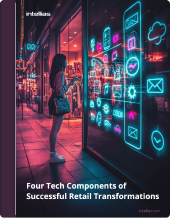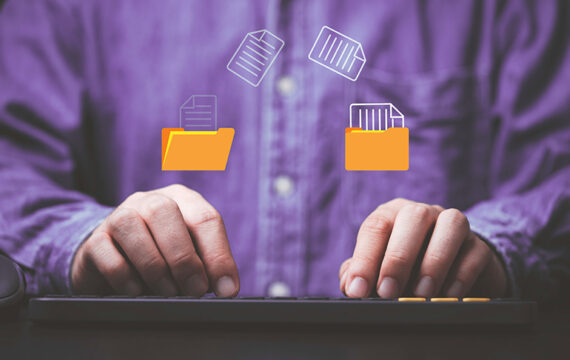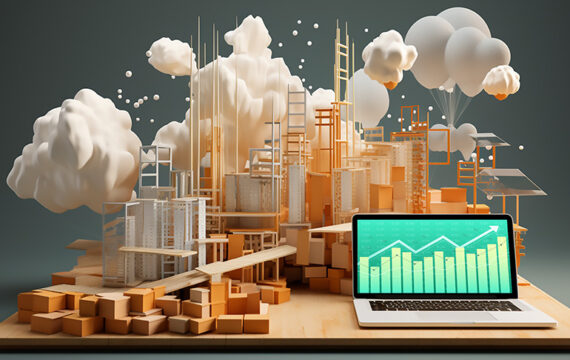Till, stock, and two sales associates — that’s how many retailers got started in the middle of the last century to later grow into multi-nation, cross-channel enterprises, counting thousands of branches, employees, and customers.
Big-box retailers entered the digital age with a lot of heritage. For some its strong brand affinity and substantial local customer bases. For others — it’s a massive estate of legacy software systems, which stall the progress in digital initiatives.
In both cases, the sheer scale of operations makes it hard to “go agile” with the help of technologies. Something as simple as adding contactless payment processing can take a couple of weeks for smaller retailers and months of meticulous planning, procurement, and installation for larger players.
Similarly, almost every retail SaaS vendor offers hot-key access to increased productivity, operational savings, and targeted promotions with its toolkit. The problem, however, is that such toolkits rarely scale to the required size.
Technology is often promoted as a “magic bullet” to whichever obstacle the company is facing. And while technology indeed can be a powerful remedy to the cause, it’s a tool to an end, not a solution in itself.
To usher in the future of retail larger players need a step-by-step strategy for progressive evolution, aligned with the business goals and the new shaping forces on the market.
From present to the future of retail: Building a path forward to profitability

Consumer spending represents 60% to 70% of the total gross domestic product (GDP) in mature economies with the retail industry, driving a substantial part of it.
When rising interest rates and inflation hit the market, retailers are the first to experience the squeeze effect of growing materials, logistics, and merchandising costs against declining consumer spending.
That said, consumer spending never dries up completely, but rather it shifts across product categories and fluctuates in terms of purchase cycles. B2B buyers with better cash flow tend to create ‘just-in-case’ surpluses before another price hike, while others might want to delay some of the bigger-ticket purchases.
Likewise, as pricing becomes a more sensitive issue, both B2B and B2C consumers shop around for deals and seek out better customer experiences (CX).
Over 70% of consumers say they will continue buying from companies that increase their prices if they feel valued as a customer. However, over 60% also expect immediate improvements in CX as prices rise.
The challenge, however, is that improvements in CX must happen across channels. Shoppers want to seamlessly switch between digital, physical, and virtual in-store interfaces, with growing preferences for digital activity.
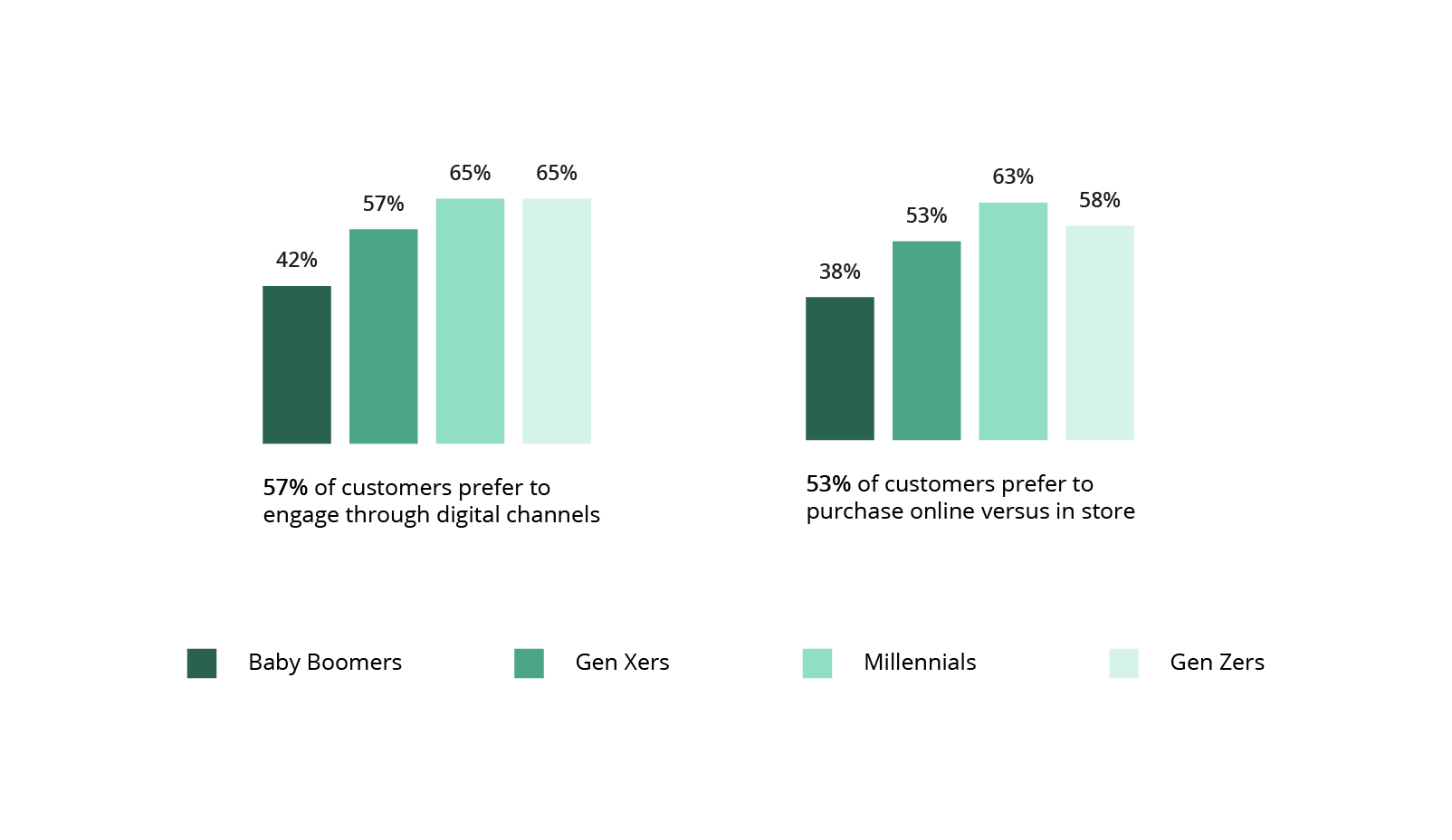
Source: Salesforce — State of the Connected Customer 2022.
Technology undeniably has become the driving force of the future of brick-and-mortar retail, as well as eCommerce. Faster response to demand fluctuations, leaner inventory management processes, and a multi-channel presence separate leading retailers from the laggers.
The wrinkle, however, is that the retail “back end” cannot always catch up with the “front end”. Sales associates lack visibility into inventory and need to perform manual in-store product counts. In-store and online assortment vary a lot and retailers struggle to identify consumers across channels.
To deliver measurable improvements in CX retailers need to strike a better balance between their front and back operations. A series of targeted technology investments can help retailers achieve parity in digital and physical channels and establish future-proof retail operations.
Customer experience alignment on the technology level
| Front-end (Customer) | Back-end (Retailer) | |
|---|---|---|
| Merchandising | Good product selection, personalized recommendations; ability to easily locate preferred goods. | Localized product assortment per branch, optimized product selection by channels, analytics-driven up-sells/cross-sells. |
| Inventory | Option to verify product stock online/in-store, timely re-stock updated, alternative ordering options (“endless aisle”) | Unified inventory management system, demand-driven stock planning, timely re-stocks, driven by real-time sales data. |
| Labor | Competent assistance is available in-store and online. Tailored advisory, based on preferences, past purchase history, and loyalty status. | CRM system offers a 360-degree view of the customer, integrated with customer service tools and in-store customer/employee devices. |
| Pricing | Fair, competitive prices. Relevant sales offers and promotions. | Dynamic pricing software with advanced sales forecasting and price optimization capabilities. |
| Fulfillment | Wide selection of delivery methods. Efficient order pick-up experience. | Integrations with multiple 3PL and logistics partners; data-driven in-store fulfillment hub. |
| Returns | Easy, channel-agnostic return experience. Fast refunds. | Strong reverse logistics function, and instant payment processing. |
Mobile workforce solutions
Frontline workers — sales associates, store managers, cashiers, clerks, and order fillers — are a huge asset for brick-and-mortar retailers. They have direct contact with the customers and accumulate a wealth of data. Similarly, their daily actions shape your brand perception and hard metrics like sales-per-square meter, shopper yield growth, and ultimately — revenue volume.
Yet, the future retail technology has yet to reach the frontline. In-store workers lack digital mobility — tools to perform back-room and customer servicing tasks on the go. Among US consumers, 54% expect sales associates to be equipped with a mobile device to assist them with stock availability verification, according to a survey by Newstore. Also, 41% want store associates to have access to their loyalty accounts.
In practice, however, over half of bix-box retailers express dissatisfaction with the available digital tools, customer experience, or both. Apart from retail KPIs, missing digital capabilities directly affects retail employees’ morale, job satisfaction, and performance levels.
Only one in eight retail employees feels omni-connected at work i.e., highly connected to each other, their leaders, and their work.
The retail industry is facing record talent shortages with almost 9 in 10 retail executives further worried about turnover rates. While better pay and benefits obviously play a role in staff retention, access to better technologies and a greater degree of connectivity also affect the employees’ decision to stay or leave.
Accenture found that omni-connected experiences account for 59% of a retail employee’s intention to say. Omni-connection means increased connectivity, allowing staffers to forge better relationships, become more productive in their work, and grow their careers.
By investing in better digital infrastructure for the frontline workforce, retailers can not only address the turnover rates, but also increase key business metrics around performance, productivity, and sales targets.
Home Depot equipped its workforce with over 40,000 new mobile devices, which include embedded barcode scanners, mag-stripe payment-card readers, and, most recently, — a machine learning (ML) powered app for managing in-store stock. The new app, dubbed, Sidekick, helps associates prioritize re-stocks and product placements in-store based on real-time data. The app alerts employees about which task needs to be completed first, provides instructions, and helps staff locate products faster using computer vision.
Walmart also rolled out over 740,000 custom-configured Samsung devices to its US workforce to improve their on-the-job performance. Through a Me@Walmart app, employees can update their schedules and swap shifts, plus get access to a host of other workplace tools for assisting customers.
In-store mobile solutions help maintain an engaged, productive workforce, capable of delivering experience-driven customer service. Real-time access to stock information, the ability to place online orders for in-house customers, better inventory management tools, and mobile POS will be the pillar solutions in the retail stores of the future.
Mobile solutions will become even more important as stores progressively evolve into phygital experience hubs — showrooms, where consumers can experience and engage with a curated range of products, then order them online.
Small-format stores allow retailers to optimize operating costs while creating stronger ties with the local community of consumers. Retailers can create new opportunities to connect with customers and drive sales by offering tailored assortments and digitally-led customer experiences in small-format stores.
Nike, for example, continues to expand its network of Nike Live stores — digitally-enabled locations with localized assortment. Nike Plus members can chat with associates via an app prior to their visit, request specific sizing, get product information, book a slot for shoe fittings of reserved models, or place an online order. Such units are also equipped with ship-from-store capabilities, which speed up order fulfillment.
Levi’s also heavily extended its footprint of NextGen concept stores. Equipped with digital features like its Fit Camp system for inventory lookup and Tailor Shop jeans personalization tool, NextGen stores are the retailer’s response to growing online sales volume. The company’s D2C stores and eCommerce sales accounted for 31% and 8% of total revenues respectively in Q4 2022.
Technology components
- Mobile retail devices with custom firmware and software applications, designed to facilitate in-store operations.
- Centralized workforce management software, accessible via web and mobile, for labor force management and optimization.
- Mobile POS solutions for on-the-go customer checkout and flexible payment processing.
- In-store “smart” technology, powered by IoT, to bring more digital experience into the physical premises.
The future of retail state in 2025
Leading retailers will operate a mix of “classic” physical stores and experience-driven, digital hubs across markets to optimize operating costs and maximize foot traffic conversions. Sales associates will be empowered with mobile tools to advise, engage, and retain in-store shoppers while staying atop other back-office tasks.
In-store fulfillment
In-store pickups and the growing volume of online deliveries were initially seen as a temp behavioral change, but it now turned into a “sticky” habit. Over the past years, 40% of European consumers (UK, France, Spain) tried click-and-collect delivery. An estimated 16 million US consumers picked up their online purchases in-store or curbside recently, a 37% increase from the previous year.
Yet retailers with large brick-and-mortar footprints often don’t rush to implement new delivery models. After all, why bother when you can cross-sell more to consumers, casual wondering down the aisle? Hold that thought.
A recent analysis of 49 million online and in-store transactions from a national US retail chain found an interesting trend. When the retailer’s competitor implemented BOPIS, the company’s sales dropped by 4.7% online and 1.8% in-store. The closer the store was to a competitor location, the greater the decline in in-store sales was. In other words: the competitor was not only siphoning the company’s online sales but also — their in-store traffic.
Earlier research also found some interesting correlations between BOPIS introduction and sales trends: many retailers would experience a drop in online sales and a rise in in-store sales after launching click&collect services.
Why is that so?
First of all, most consumers now begin their online journey online (research and comparison), but end up buying in-store to avoid delivery fees or inflexible pickup times. Tools like “click-and-collect” or “in-store availability” enable consumers to check product stock levels before planning their trip.
Secondly, BOPIS also drives foot traffic to the store, which leads to a higher average basket size. Over 85% of US shoppers made extra in-store purchases after doing their online order pickup.
The problem, however, is that services such as same-day delivery or near-instant store pick-up are expensive to operate. Especially, when consumers expect a free and fast delivery: 62% of shoppers expect their orders to arrive in less than 3 business days when choosing free shipping (and most also want free same or next-day shipping after a certain threshold).
The solution? Building cost- and labor-effective in-store fulfillment hub to power local deliveries.
Instead of relying on warehouses and expensive 3PL partners, larger retailers can progressively transform their brick-and-mortar footprint into a “shadow” logistics network, which handles local order delivery.
Target implemented in-store pickup for online orders back in 2017 to stave off Amazon Prime’s two-day shipping. Between Nov-Dec 2018, Target’s digital sales grew by 29%, entirely driven by store-fulfilled digital sales. A year later, Target also added ship-from-store capabilities, which grew 50% year over year during the third quarter of 2019. By Q1 2021, 95% of online orders (in stores and online) from its physical locations, saving substantially on warehousing and logistics costs. Presently, Target plans to allocate most of the space in its new larger-format stores to order fulfillment.
Technology components:
- Advanced inventory management technology, which provides accurate item-level visibility in each service area/market (e.g., one that’s powered by RFID)
- Centralized order management system (OMS), which auto-routes the order request to the nearest retail location with the in-stock inventory.
- Demand-driven inventory replenishment tools to flexibly respond to event-driven (e.g., weather, promotion, etc) fluctuations in product demand.
- Mobile fulfillment tools for work queue management and wave planning, which allow running a micro-warehouse operation efficiently.
The future of retail state in 2025
Big box retailers will repurpose space in large-format locations into dark stores — warehouse-like nodes, capable of local order fulfillment at a high frequency. Each dark store location will leverage big data for demand sensing, dynamic supply allocation, and capacity planning, which would accelerate multi-channel order fulfillment.
Localized assortment, extended by the endless aisle
Smartphones are the new gateway to shopping. On 60% of shopping occasions, consumers head online first. Product information look-up, review analysis, or sneaky price comparisons, shoppers reach for their phone at home, on the go, and in-store.
46% of global in-store shoppers used smartphones to enhance their most recent in-store shopping journey.
The rationale for extensive digital research is simple: shoppers don’t want to waste time on not-always-pleasant in-store trips.
Over the last year, nearly seven in ten global consumers said that rising prices had the greatest impact on their in-store shopping experiences (68%), followed by product stock-outs (42%), and the hassle of standing in long queues (39%).
Moreover, many grew frustrated with frequent stock-outs. When shoppers don’t see their preferred brands on the shelf, their purchase intention dwindles. Instacart observed that consumers avoid buying products, which are running low on site: There was a 25% relative reduction in the proportion of items ordered that were likely to be out of stock.
In other words: Consumers are less prone to scarcity biases and more concerned about getting what they need, whether they travel to the store or place an order online.
Yet, retailers don’t rush to fill in the shelves up to the brink because overstock (and subsequent dead inventory) is more expensive to handle than occasional stock-outs. A jumbo-sized inventory also required a bigger labor force to effectively handle it.
To balance the demand with the supply, leading retailers are creating targeted, hyperlocal assortments for each branch, while moving the other inventory to digital shelves. Better analytics guides them in these decisions.
The new generation of retail assortment management applications (RAMAs), powered by machine learning (ML) algorithms, allow retailers to better understand apparent and latent shopper behaviors; demand drivers; and supply constraints. Then adapt the in-store product assortment, presentation, and promotion accordingly.
Fashion retailer, River Island relies on an AI-driven platform for assortment optimization. With a new data management and processing infrastructure in place, the company can optimize stock levels with extra granularity. For example, by analyzing the store footfall during the summer heatwave, River Island found that people frequented shops in covered shopping centers to escape the hot temperature, so they adjusted the stock volumes and staff shifts accordingly to deal with the unexpected demand.
Overall, an AI-powered RAMA enabled River Island to better plan product allocations across its 250+ store locations in the UK and improve flexibility in inventory management. As a result, the company saw a 23.7% reduction in stockout frequency and a 28.3% reduction in lost sales opportunities, according to a case study.
In terms of cost efficiency, a smaller inventory is great, but what about customer retention and upselling?
For that, you have endless aisle solutions — a network of in-store digital interfaces and self-service kiosks, offering consumers to shop for products that are not available on the shelf.
Shoppers used to the instant availability of eCommerce, now expect the same treatment in stores. Over 67% of US consumers expect sales associates to sell them products even if they’re not available in the store at present.
Strategically placed around the premises, endless aisle solutions can help customers learn about different product configurations; order out-of-stock or non-available items for pick-up or online delivery; customize product design or warranty policy.
Defensively, an endless aisle can be used to save a sale when a certain product is out of stock. Offensively, it can be configured to suggest upsells and cross-sells, especially by retailers with large inventories.
An endless aisle enables retailers to give consumers what they want from any store without increasing inventory carrying costs and risks. When combined with in-store fulfillment operations, the endless aisle concept allows retailers to fulfill orders at blazing speed.
Technology components
- Robust retail data management infrastructure to collect and operationalize inventory and sales data across the board.
- Prescriptive assortment planning and first allocation, based on real-time data from each branch as well as external market and behavioral signals.
- Automated replenishment, based on online and offline stock dynamics with direct reservation dispatches to the warehouse. Data sharing with the warehousing and/or in-store fulfillment units for optimized workforce management.
- In-store digital displays, offering easy customer identification and the ability to explore, order, and customize products, synchronized with back-office systems for order fulfillment and inventory management.
The future of retail state in 2025
By 2025, all global multichannel fashion retailers will use AI and automation to create more targeted assortments, reducing item choices by up to 30%. Also, roughly 15% of the retail stores of the future will include digital isles, where consumers can explore the full product catalog, order out-of-stock goods, and receive personalized recommendations, based on their loyalty status.
Data-driven retail pricing
Growing inflation in almost every market cuts into consumer discretionary spending. Globally, 48% of consumers say that rising prices of household goods is something they’ve experienced frequently over the last year.
The concern is justifiable as in the US alone the consumer price index (CPI) increased by 5% year-on-year. High interest rates, in turn, affect B2B sales volumes with larger manufacturers seeking out deals to optimize their sourcing costs.
Likewise, consumers no longer treat price as the dominant decision-making factor. Exclusivity, convenience, and experience increasingly define the consumers’ willingness to pay the proposed number. In other words: consumers seek better value, which can be seen as a combination of both financial (price, markdown, delivery costs) and non-financial factors (local availability, in-store experience, brand affinity).
66% of global consumers will be more focused on value for money in the future.
The shift to value-based pricing requires retailers to review their approaches to profit margin optimization, as well as pricing and promotion strategies.
Amazon arguably pioneered the concept of dynamic pricing in retail. Over the years, the company built out a high-dimensional pricing optimization model, which suggests the optimal price ranges for different product categories, based on near-real-time fluctuations in demand.
Tesco, in turn, started out with a simpler sales prediction model back in 2016, designed to better understand the fluctuations in customer behavior. By applying clustering and other analytical techniques, Tesco located better cross-sell opportunities and gained the capabilities to predict sales likelihood across product categories.
The abundance of big data, paired with state-of-the-art machine learning algorithms, enables retailers to better understand:
- Perceived value drivers: best-selling items with sustained demand
- Assortment perception drivers: best product pairings for upsell and cross-sell deals.
- Traffic drivers: In-demand products across categories, which have high-volume, short-term demand.
By knowing Key Value Items (KVIs) and Key Value Categories (KVCs) retailers can better optimize stock by location and maximize the likelihood of sale across different channels. Then optimize back office operations, based on this data. Nike, for instance, uses predictive analytics technology to determine what inventory should be positioned in its warehouse for faster delivery speed and optimized fulfillment costs. Predictive intel helps Nike allocate the most in-demand inventory to the warehouses to offer one- or two-day shipping.
At the frontline, retailers still rely on legacy trade promotion management (TPM) systems or even spreadsheets, which reflects poorly on promotion performance. Statistically, half of such promotions end up being not profitable for retailers. Lack of data visibility, rigid rules, and gut-based decision-making are to blame for that.
Predictive analytics can bring data and greater objectivity into decisions on pricing, promotion, and markdown optimization across markets, branches, and individual products. Modern Unified Price, Promotion, and Markdown Optimization (UPPMO) systems allow retailers to model different pricing scenarios, using target profit margin and revenue goals as variables to determine the best course of action.
Farmacorp, a Bolivian pharmacy chain, implemented an AI-driven price optimization solution to customize its target price strategies across three distinct product lines and shopping channels. With a new price and promotion recommendation engine, the chain saw a
10% YoY revenue growth, plus achieved 108% of the planned profit goal for the year.
REWE Group, in turn, went with SymphonyAI’s solutions to gain better insights into their customer demographics and deploy highly-personalized, omnichannel promotional campaigns. The new pricing optimization system can scan through over 8 million transactions each week and provides REWE teams with better behavioral insights and ample opportunities for differentiation.
Technology components:
- Data storage architecture. Predictive analytics requires a secure, flexible, and high-performance architecture for provisioning raw data for analytics use cases.
- Data pipelines help deliver data from connected business systems (cloud-based or on-premises) to analytics algorithms and self-service business intelligence tools.
- UPPMO software enables retailers to run advanced sales and demand modeling scenarios to make better pricing decisions.
- Predictive analytics algorithms can be deployed to support a wider range of custom use cases for pricing & promotion strategy optimization
The future of retail state in 2025
Pricing decisions will be driven by real-time data on purchase behaviors across channels, as well as external insights. Promotions and markdowns will be hyper-personalized, based on the available customer data. Managers will be able to model what-if scenarios, based on multiple decision parameters in minutes to determine the next best action.
The pinnacle of future-proof retail: Unified commerce experience
All of the above retail digital solutions are the stepping stones towards a bigger goal — a unified commerce experience.
Unified commerce aims to bring consistency in cross-channel sales experiences through better data exchanges, customer-centric analytics, and experience-led shopping experiences.
Retailers are pressed by a plethora of operational issues. These can be resolved with the right technology to secure quick wins. Yet, to remain competitive in the long term you need a centralized hub, which unites all the adopted tools into one, robust technology platform.
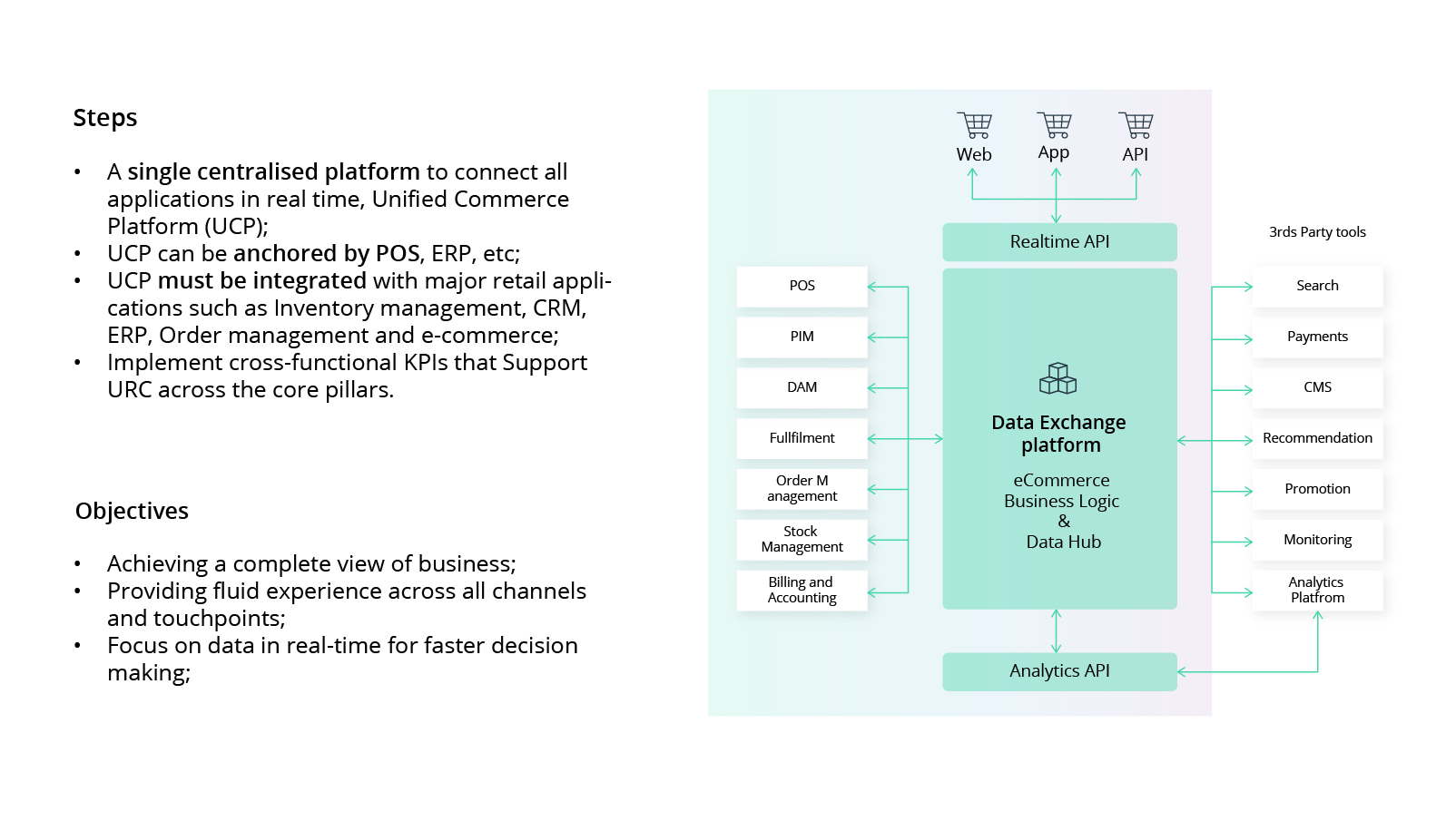
A unified commerce platform (UCP) is a collection of sub-systems, data flows, and cross-unit processes, designed to serve your key business objectives:
- 360-degree visibility of the business
- Real-time data accessibility
- Experience optimization across touchpoints
Effectively, a UCP connects all the systems present in your portfolio (POS, RAMA, Stock Management, etc) to a centralized data exchange platform, which serves as a single source of truth for your entire business.
The data exchange platform can be used to create custom business logic and analytics rules to power processes across the connected systems and provision data to connected applications — be it an internal dynamic pricing engine or an in-store self-ordering kiosk.
On the backend, your workforce receives an all-connected experience and full visibility into every channel and touchpoint, with the necessary data available at their fingertips. At the front end, a UCP allows you to easily deploy new customer experiences online and in-store to meet your sales targets.
The future of retail starts today
The retail industry is no stranger to market calamities. Yet, today’s landscape is more than a collection of one-off events. It’s a continuous flow of disruptive forces, constantly testing the retailers’ operational efficiency, resilience, and agility levels.
Supply chains get tested in terms of fragility. Logistics becomes a core part of retail operations and customer experience expectations accelerate. Sector convergence and rapid tech shifts present both operational challenges and opportunities for value generation.
The present-day obstacles in fulfillment, promotion planning, or inventory management progressively evolve into future competitive advantages with strategic technology investments. The future of retail unravels as we speak. So the question is whether your business will define it or carry on with the status quo.
Intellias is helping global retailers put digital technologies at the best service of their business. Let’s talk about the future of retail you aspire to build.
